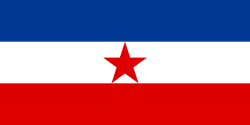National Liberation Army and Partisan Detachments of Yugoslavia
| National Liberation Army and Partisan Detachments of Yugoslavia |
|
|---|---|
| Participant in World War II in Yugoslavia | |
 7th Vojvodina Brigade entering liberated Novi Sad, 1944 
Flag of the Yugoslav Partisans
|
|
| Active | 1941–1945 |
| Ideology |
Communism, Marxism-Leninism Yugoslav national liberation |
| Leaders | Josip Broz Tito |
| Headquarters | mobile, attached to the Main Operational Group |
| Area of operations | Axis-occupied Yugoslavia |
| Size | 80,000–800,000 (see below) |
| Became | Yugoslav People's Army |
| Allies |
|
| Opponents | |
| Battles and wars | Battle of Neretva, Battle of Sutjeska, Raid on Drvar, Battle of Belgrade, Syrmian Front (most notable) |
The Yugoslav Partisans or the National Liberation Army, officially the National Liberation Army and Partisan Detachments of Yugoslavia, was the Communist-led resistance to the Axis powers (chiefly Germany) in occupied Yugoslavia during World War II.
It is considered to be Europe's most effective anti-Axis resistance movement during World War II, often compared to the Polish resistance movement, albeit the latter was a mostly non-communist autonomous movement. The Yugoslav Resistance was led by the Communist Party of Yugoslavia during World War II. Its commander was Marshal Josip Broz Tito.
One of two objectives of the movement, which was the military arm of the Unitary National Liberation Front (UNOF) coalition, led by the Communist Party of Yugoslavia (KPJ) and represented by the Anti-Fascist Council for the National Liberation of Yugoslavia (AVNOJ), the Yugoslav wartime deliberative assembly, was to fight the occupying forces. Until British supplies began to arrive in appreciable quantities in 1944, the occupiers were the only source of arms. The other objective was to create a federal multi-ethnic communist state in Yugoslavia. To this end, the KPJ attempted to appeal to all the various ethnic groups within Yugoslavia, by preserving the rights of each group.
...
Wikipedia
